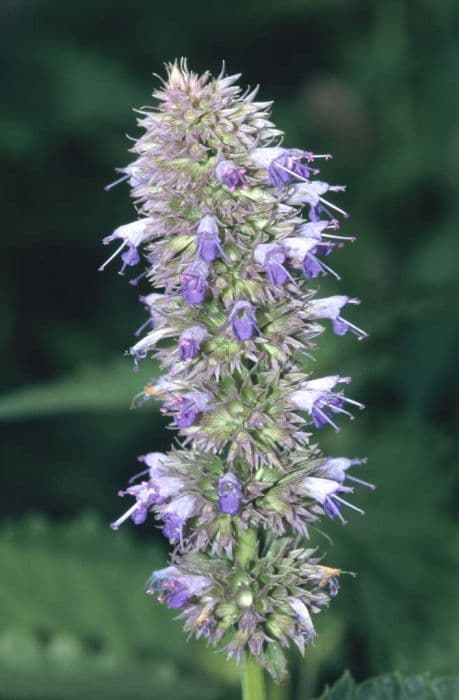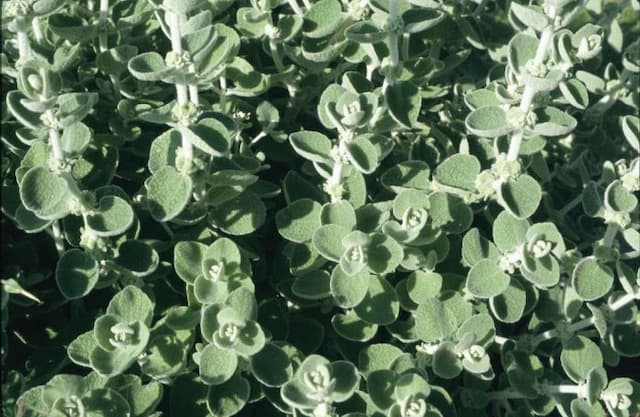Pyramid Bugle Ajuga pyramidalis

ABOUT
Ajuga pyramidalis, commonly known as the pyramid bugle, is a spreading perennial that forms a dense mat of foliage. It can be recognized by its rosettes of glossy, dark green leaves, which sometimes have a hint of bronze. The leaves are oval-shaped with a rounded tip and have a slightly puckered surface. Edges of the leaves are scalloped and may appear slightly serrated on closer observation. During the blooming season, pyramid bugle produces erect flower spikes that bear whorls of tubular flowers. These flowers are typically found in shades of blue or purple, which provide a vibrant contrast against the dark foliage. The flower spikes rise distinctly above the foliage, standing out due to their height and the brightness of the blossoms. The overall impression of the plant is one of lushness, with a ground-hugging habit that provides a continuous cover of green, punctuated by the vertical interest of its blooming flower spikes.
About this plant
 Names
NamesFamily
Lamiaceae
Synonyms
Pyramid Bugle, Metalweed
Common names
Ajuga genevensis var. pyramidalis, Ajuga pyramidalis var. alpina, Ajuga pyramidalis var. subglabra
 Toxicity
ToxicityTo humans
Ajuga pyramidalis, more commonly known as Pyramidal Bugle, is not widely recognized as a toxic plant to humans. However, plants can contain compounds that may cause reactions in some individuals, particularly if they have specific allergies or sensitivities. The general scientific consensus is that this plant poses little to no toxicity risk upon ingestion by humans. Despite this, precaution should always be taken as individual reactions can vary. It is always recommended to consult with a medical professional if someone has ingested a plant and is feeling unwell.
To pets
Ajuga pyramidalis, known as Pyramidal Bugle, is not typically listed as a toxic plant to pets such as dogs and cats. While the plant is generally not considered dangerous, pets may still experience mild gastrointestinal upset if they consume large amounts of this plant due to the varied nature of animal reactions to plant materials. Typical symptoms may include vomiting or diarrhea. If such symptoms occur, it is best to consult a veterinarian. Always exercise caution and prevent pets from eating plants that are not confirmed to be safe.
 Characteristics
CharacteristicsLife cycle
Perennials
Foliage type
Evergreen
Color of leaves
Green
Flower color
Blue
Height
6-9 inches (15-23 cm)
Spread
6-12 inches (15-30 cm)
Plant type
Herb
Hardiness zones
3
Native area
Europe
Benefits
 General Benefits
General Benefits- Ornamental Appeal: Ajuga pyramidalis, commonly known as Pyramidal Bugle, features attractive foliage and vibrant blue flowers that can enhance the aesthetics of gardens and landscapes.
- Ground Cover: It is an effective ground cover plant that spreads easily, preventing weed growth and covering bare spots in gardens.
- Low Maintenance: Pyramidal Bugle requires minimal care once established, making it ideal for gardeners looking for low-effort plants.
- Drought Tolerance: The plant can withstand periods of dryness once established, reducing the need for frequent watering.
- Pollinator Attraction: The flowers of Pyramidal Bugle attract bees and butterflies, supporting local ecosystems and pollinator populations.
- Erosion Control: Its dense growth habit helps stabilize soil and prevent erosion on slopes and in areas prone to soil loss.
- Shade Tolerance: Pyramidal Bugle can thrive in shaded areas where other plants might struggle, making it suitable for woodland gardens.
- Deer Resistance: This plant is not a favorite of deer, which makes it a good choice for gardens in areas with high deer populations.
- Seasonal Interest: Ajuga pyramidalis offers seasonal interest with its foliage color changes and spring blooms, contributing to the garden's year-round appeal.
- Texture Contrast: Its foliage provides textural contrast when planted alongside other garden plants, enhancing visual interest.
 Medical Properties
Medical PropertiesThis plant is not used for medical purposes.
 Air-purifying Qualities
Air-purifying QualitiesThis plant is not specifically known for air purifying qualities.
 Other Uses
Other Uses- Ajuga pyramidalis, known as Pyramidal Bugle, can be used to create a low-maintenance ground cover in gardens, thriving well in shaded areas and creating a dense mat that suppresses weeds.
- The plant's flowers are attractive to bees and butterflies, making it an excellent choice for pollinator gardens or biodiversity hotspots.
- Pyramidal Bugle can be used in rock gardens, as its compact growth habit suits the crevices and helps stabilize the soil.
- Some gardeners use Pyramidal Bugle in container gardens for its textured foliage and spring flower spikes that add vertical interest.
- Due to its rhizomatous roots, the plant can be employed in erosion control efforts on slopes or banks prone to soil erosion.
- Pyramidal Bugle can serve as a living mulch due to its thick foliage, helping to retain soil moisture and reduce evaporative water loss from the soil.
- The plant's attractive foliage, which can have hints of bronze and purple, is used in landscape design for color contrast against green lawns or brighter colored flowers.
- In water-wise or xeriscape gardening, Pyramidal Bugle can be utilized as it is drought-tolerant once established and requires minimal watering.
- For educational purposes, Pyramidal Bugle can be included in native plant gardens to teach about local flora and ecological plant-relationship dynamics.
- During spring, the blue to violet flowers of Pyramidal Bugle can be used to provide a natural, seasonal color theme in ornamental garden arrangements and borders.
Interesting Facts
 Feng Shui
Feng ShuiThe Ajuga is not used in Feng Shui practice.
 Zodiac Sign Compitability
Zodiac Sign CompitabilityThe Ajuga is not used in astrology practice.
 Plant Symbolism
Plant Symbolism- Protection: Ajuga pyramidalis, commonly known as Pyramidal Bugle, is often associated with protection. This symbolism is rooted in the plant’s dense growth that can form a protective cover on the ground.
- Perseverance: Given its hardy nature and ability to thrive in various conditions, Pyramidal Bugle also symbolizes perseverance and adaptability.
- Healing: The medicinal uses of Pyramidal Bugle in herbal remedies lend it the symbolism of healing and restoring health.
 Water
WaterFor Ajuga reptans, commonly known as Carpet Bugle, it is important to maintain moist soil, especially during the first growing season to establish a deep, extensive root system. Water the plant deeply once or twice a week, providing about one inch of water each time. Adjust the amount of water depending on rainfall, and during the hot, dry periods, you may need to water more frequently. In winter, cut back on watering as the plant requires less moisture due to cooler temperatures and dormancy. Always check the soil moisture before watering to ensure it has begun to dry out, as overwatering can lead to root rot.
 Light
LightCarpet Bugle thrives in a variety of lighting conditions, from full sun to partial shade. In hot climates, it benefits from afternoon shade to protect it from intense heat. The best spot for Carpet Bugle is where it can receive morning sunlight and partial afternoon shade, ensuring vibrant foliage color and healthy growth.
 Temperature
TemperatureThe ideal temperature range for Carpet Bugle is between 60 and 75 degrees Fahrenheit. It can tolerate a wide range of temperatures but should be protected from extreme heat above 90 degrees and extreme cold below the freezing mark. Providing mulch can help insulate the roots and keep the soil temperature more constant.
 Pruning
PruningPruning Carpet Bugle is necessary to maintain its dense mat form and to remove any damaged or dead foliage. Pruning also encourages thicker growth and can prevent or reduce issues with powdery mildew. Prune in the early spring to clean up winter damage and again after flowering, if desired, to promote a tidy appearance.
 Cleaning
CleaningAs needed
 Soil
SoilAjuga reptans, commonly known as Bugleweed, prefers well-draining soil rich in organic matter. The best soil mix is a blend of garden soil, compost, and perlite or sand to improve drainage. The ideal soil pH for Bugleweed should be slightly acidic to neutral, ranging from 6.0 to 7.0.
 Repotting
RepottingBugleweed (Ajuga reptans) does not need frequent repotting as it is a ground-cover plant. Repotting every 2-3 years or when overcrowded is sufficient.
 Humidity & Misting
Humidity & MistingBugleweed (Ajuga reptans) tolerates a wide range of humidity conditions. It thrives best in average humidity levels but can also adapt to the humidity present in most garden environments.
 Suitable locations
Suitable locationsIndoor
Place Bugleweed in bright, indirect light; water when topsoil dries.
Outdoor
Plant Bugleweed in partial shade, water regularly, and mulch.
Hardiness zone
Ajuga reptans is suitable for 3-9 USDA.
 Life cycle
Life cycleThe life cycle of Ajuga pyramidalis, commonly known as Pyramidal Bugle, begins with seed dispersal, which occurs after the flowering period in late spring or early summer. Seeds germinate, given appropriate moisture and temperature conditions, to give rise to small seedlings which then develop a rosette of basal leaves. These leaves photosynthesize and provide energy for the plant to grow and establish its root system. As the plant matures, it produces erect flowering stems in the second or third year, which bear whorls of blue or purple flowers that are attractive to pollinators such as bees. Once pollination occurs, the plant develops fruits containing seeds that complete the reproductive cycle. The Pyramidal Bugle is a perennial, allowing the plant to endure for multiple years, and in each subsequent year, it will repeat this cycle, spreading and potentially forming dense mats if conditions are favorable.
 Propogation
PropogationPropogation time
Spring to Summer
Ajuga pyramidalis, commonly known as pyramidal bugle, is propagated through division, which is the most popular method for this plant. The best time to propagate by division is in the spring after the last frost when the plant is actively growing, or in early fall to allow sufficient time for establishment before winter. To propagate by division, carefully dig up an established clump and gently separate the plant into smaller sections, ensuring that each new section has a portion of root attached. After separating, replant the divisions immediately at the same soil depth they were originally growing, spacing them about 10 to 12 inches (approx 25 to 30 cm) apart to allow for growth. Water the new plants well to help establish roots and reduce transplant shock. Regular watering should continue until the plants are well-established, after which pyramidal bugle requires minimal care, thriving in a range of conditions from full sun to partial shade.









